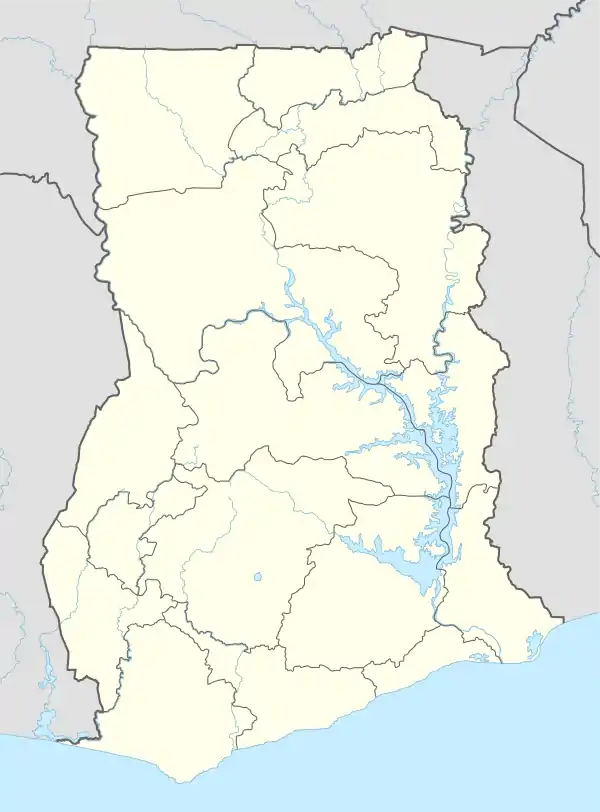Bomfobiri Wildlife Sanctuary
Bomfobiri Wildlife Sanctuary is a bird sanctuary, located about 80 km northeast of Kumasi[1] within a geographical coordinate of 06°54.595'N and 001°17.340'W. The 53 km2 Bomfobiri Wildlife Sanctuary was created in 1975 with a four distinct vegetative types such as Riverine Forest,[2] Rainforest,[3] Woodland Savannah[4] and Grassland Savannah. Animals present on the reserve include several species of birds, crocodiles,[5] baboons,[6] Mona monkeys,[7] buffalos,[8] red river hogs,[9] Maxwell's duiker,[10] red flank duiker,[11] Bushbuck[12] and monitor lizards.[13] The reserve has many forms of attraction point including the Lion Stone (a naturally carved stone resembling a lion), Stone Bridge, Bomfobiri waterfall (serving as a habitat for crocodiles), Wala waterfall (for swimming), and caves. Activities that can be engaged in includes hiking, mountain climbing, game viewing, bird watching, camping and swimming. The reserve takes the crocodile as its symbol.[14]

The best time to see the animals at the Bomfobiri Wildlife sanctuary is within in the month of November which is the dry season.[15] This is because the rainy season drives the animals deep into the forest.[16]
Establishment and legal status
The Bomfobiri Wildlife Sanctuary was established to protect the varied ecosystem and ecological values of the area. The sanctuary was originally situated within the 16.8 km2 Boumfum Forest Reserve and established under the Ashanti Authority Ordinance on the 23rd March 1946. Bamfobiri Wildlife Sanctuary was expanded to its present size and re-designated as Bomfobiri Wildlife Sanctuary (BWS) by the Wildlife Reserves (Amendment) Regulation of 1975 L.I. 1022.[17]
References
- "Ghana City Kumasi". www.ghanaweb.com. Retrieved 2019-05-25.
- Paulo van Breugel <http://ecodiv.org>. "Riverine forests (edaphic vegetation type, fr)". vecea.vegetationmap4africa.org. Retrieved 2019-05-25.
- "Rainforests". Mongabay.com. Retrieved 2019-05-25.
- "Definition of SAVANNA WOODLAND". www.merriam-webster.com. Retrieved 2019-05-25.
- Bradford, Alina; June 25, Live Science Contributor |; ET, 2014 02:34pm. "Crocodiles: Facts & Pictures". Live Science. Retrieved 2019-05-25.
- Bradford, Alina; January 20, Live Science Contributor |; ET, 2017 11:02pm. "Facts About Baboons". Live Science. Retrieved 2019-05-25.
- Liu, Sonia. "Cercopithecus mona (mona monkey)". Animal Diversity Web. Retrieved 2019-05-25.
- "The most abundant large herbivore in Africa is on a downward trend". African Wildlife Foundation. 2013-02-22. Retrieved 2019-05-25.
- "Red River hog". Smithsonian's National Zoo. 2016-04-25. Retrieved 2019-05-25.
- "Maxwell's Duiker (Philantomba maxwellii)". iNaturalist.org. Retrieved 2019-05-25.
- "Red-flanked duiker (Cephalophus rufilatus) - Detailed information". www.ultimateungulate.com. Retrieved 2019-05-25.
- "Learn more about the bushbuck". African Wildlife Foundation. 2013-02-22. Retrieved 2019-05-25.
- Hays, Jeffrey. "MONITOR LIZARDS AND REPTILES | Facts and Details". factsanddetails.com. Retrieved 2019-05-25.
- "Bomfobiri Wildlife Sanctuary". Ghana Wildlife Society. Archived from the original on 30 May 2016. Retrieved 27 April 2016.
- "Kumawu Assembly to upgrade Bomfobiri Wildlife Sanctuary". www.ghanaweb.com. Retrieved 2019-05-18.
- "The Epic Journey Into The Bomfobiri Wildlife Sanctuary". We Discover Africa. 2017-07-02. Retrieved 2019-05-18.
- "Bomfobiri Wildlife Sanctuary". NYU-CTED Kumawu Project. Archived from the original on 2019-06-05. Retrieved 2019-05-18.